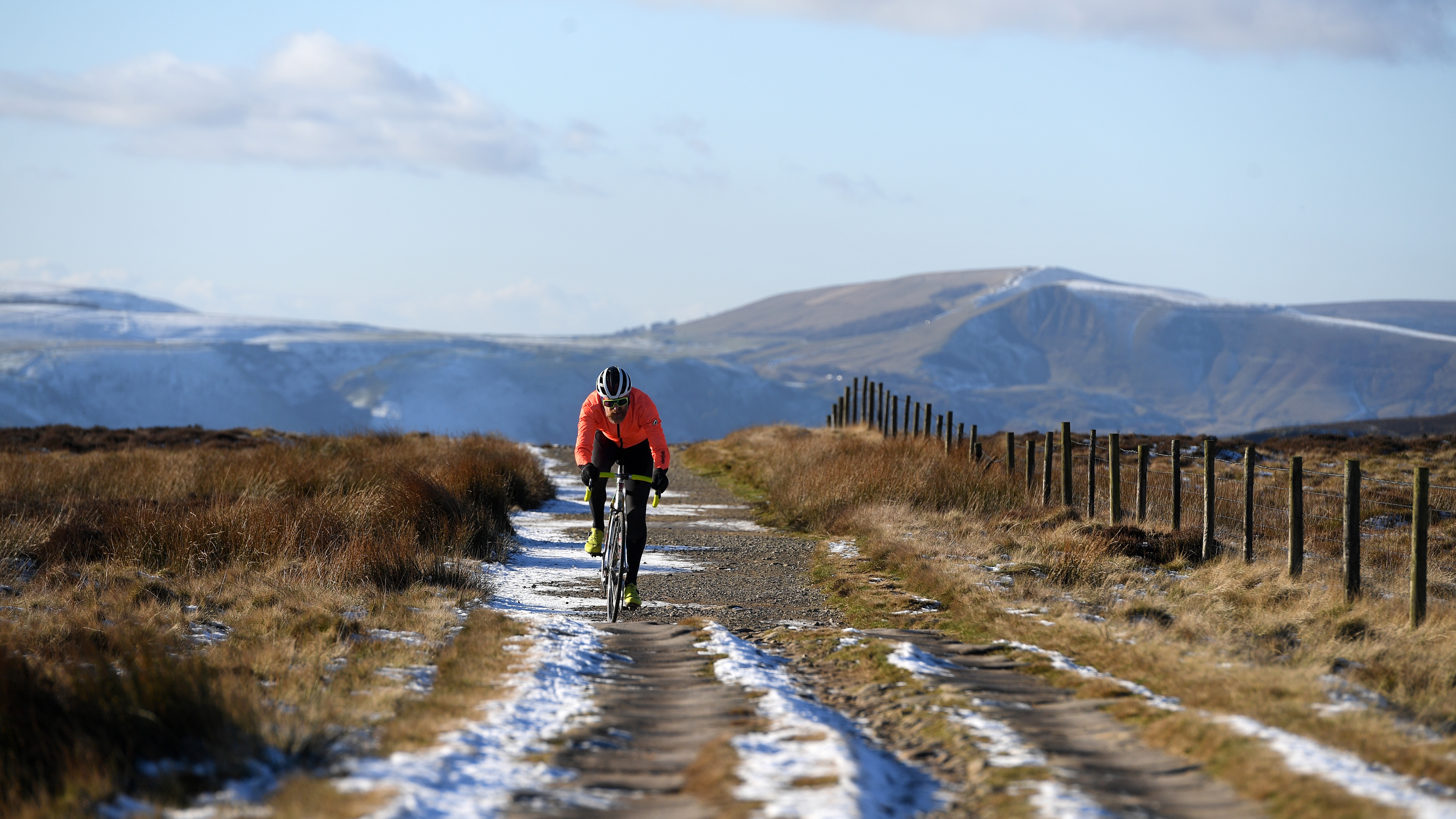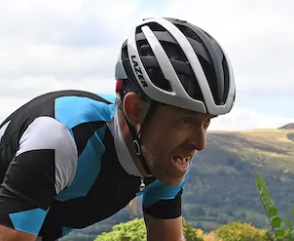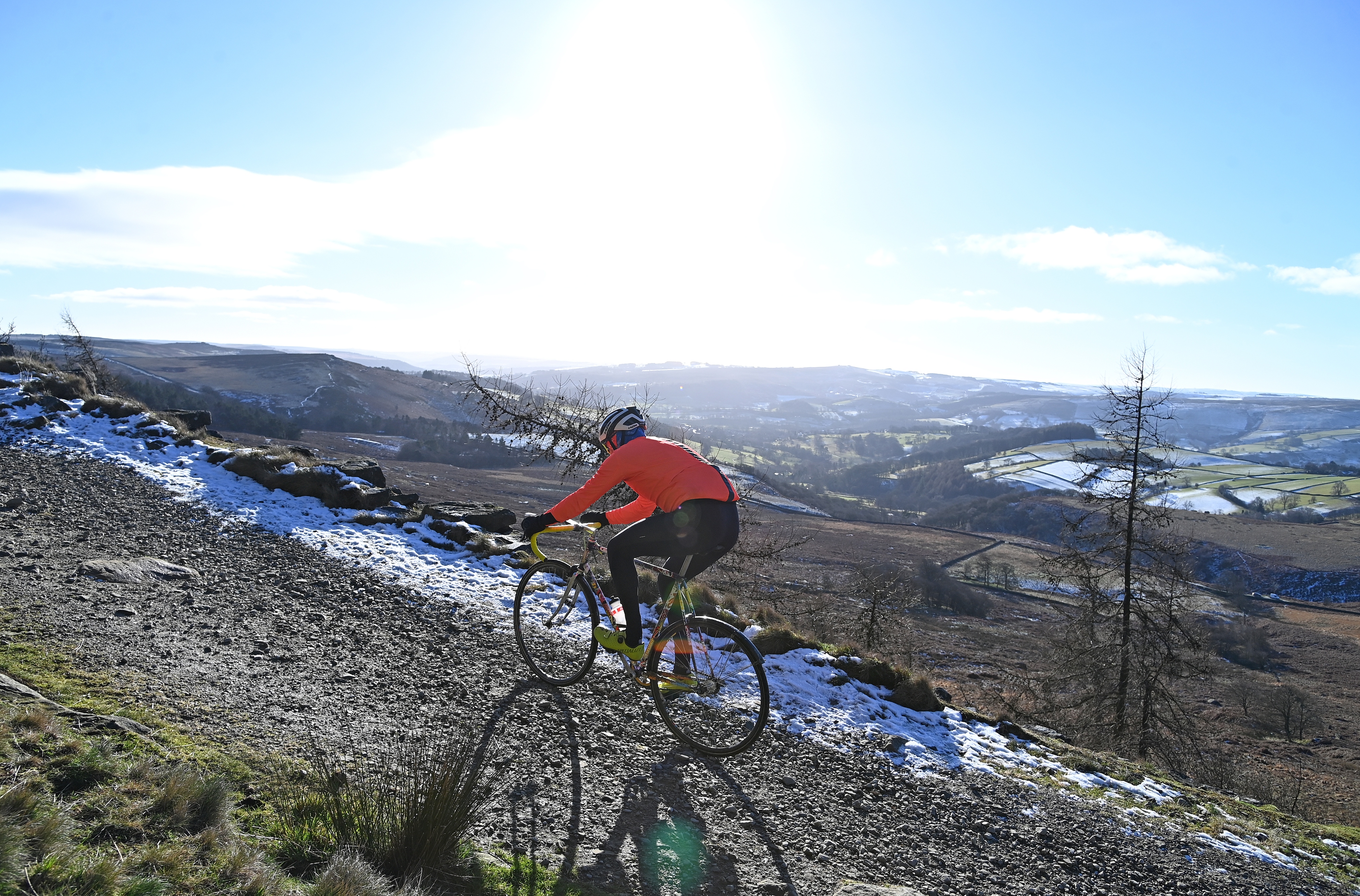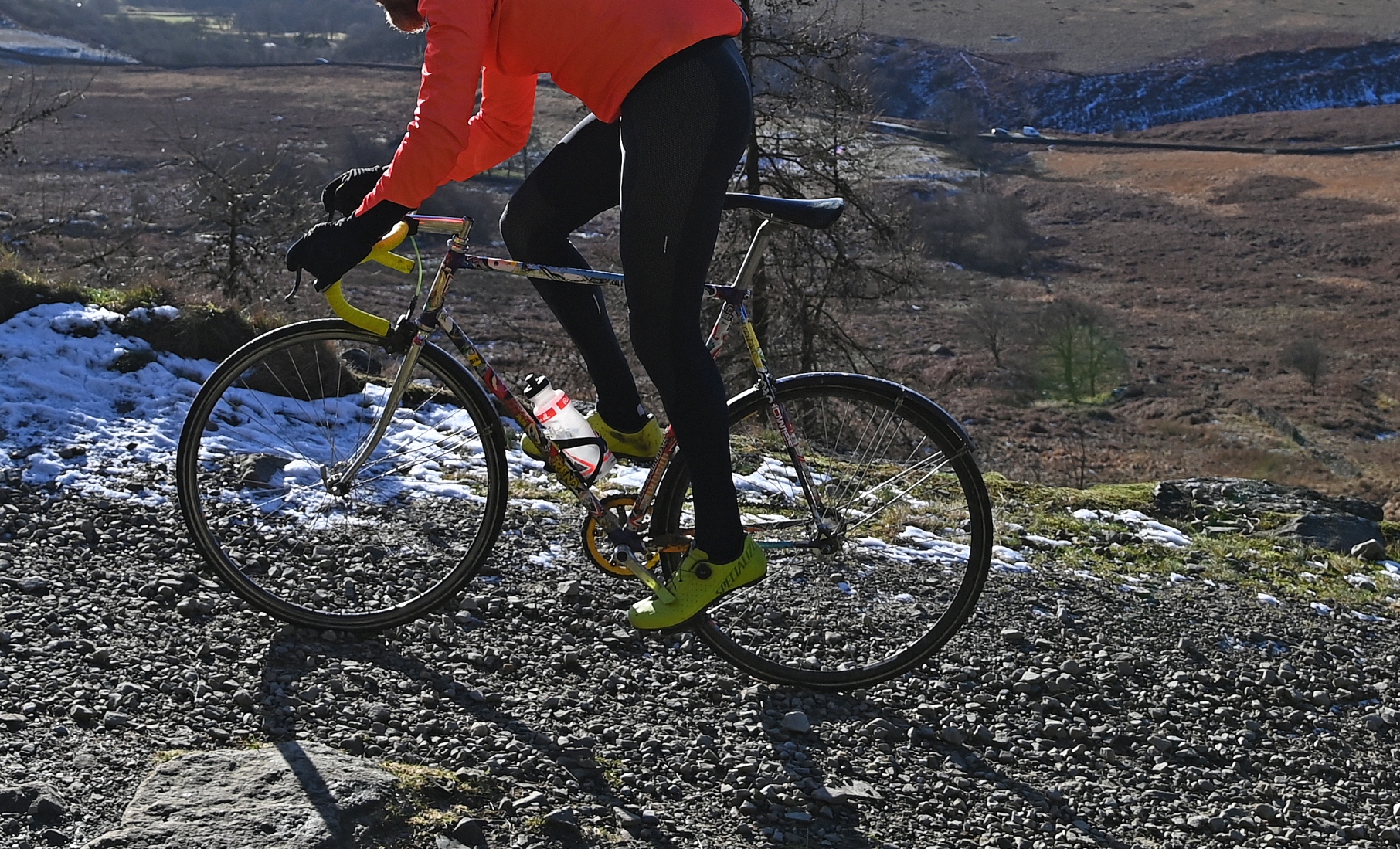'Forcing a 69-inch gear up a 15% gradient on a muddy track with 23mm tires is proper training': Original gravel fights back
Take a fixed-wheel bike off-road this winter and you’ll discover that they’re a hack-of-all-trades and a master of fun, says Simon Warren


The weather in the UK can be pretty dire over winter, with a repertoire including freezing rain, ice and snow. So to break up the monotony of cranking out miles on the roads, or avoiding them because they’re just too dangerous, I like to take to the trails. Not unusual in itself, but the thing is, I don’t own a mountain bike or a cross bike or even a gravel bike. So what do I ride? My steel-framed, odd- wheeled, 59-inch fixed-geared, single front-braked, no-nonsense ‘hack’ bike, that’s what.
Back in the late ’80s at my first cycling club, Newark Castle CC, it became apparent that if I was going to join in with the pre-Christmas club rides, then owning such a machine was a necessity. In the period between the end of the hill-climb season and the start of proper winter training, the idea was to just have fun, with no structure, no pressure and no goals – a big part of this involved riding a fixed gear, everywhere.
For the uninitiated, a fixed-gear bike is essentially a track bike with a brake at the front to make it legal. The sprocket is fixed to the rear wheel without a freewheel so you only stop pedalling when you stop moving. Up to this point I’d never owned a track bike or even seen a velodrome, so riding fixed was a whole new experience.
Clubman's traditions

In bygone days, generations of experienced club riders rode fixed throughout the winter – just an old, heavy steel frame, a single gear and a single brake. With very little to maintain, once you got home you could just chuck the bike in the shed, job done. In addition, it was said to improve your pedalling action; since you can’t stop pedalling a fixed gear, four hours on the bike equals four hours of turning the pedals and is therefore great practice. Whether or not it improved technique is up for debate; like a lot of things in cycling it might just have been an old tradition that refused to die regardless of whether it was good for you or not.
"With 90% of current advertising aimed at folk prepared to drop £10,000 on the latest bike, this concept may seem alien to the modern consumer, but yes, there is another way."
In our club, led by our mentor Dave Kennedy, everyone had a hack bike, and along with crunching the miles on the road, we took it to the next level, taking them off-road. Long before a multitude of surface-specific machines had been dreamt up by the marketing teams of the global corporations, our bodged together piles of scrap were just fine. With 90% of current advertising aimed at folk prepared to drop £10,000 on the latest bike, this concept may seem alien to the modern consumer, but yes, there is another way.
A typical Sunday would involve an hour on tarmac to get out of town, then, following an abrupt turn into a field, a couple of hours on lanes, tracks and paths; basically, anything our machines could handle. Through Sherwood Forest and Clumber Park, along Ermine Street and the Monsal trail, we rode anywhere and everywhere our club’s elders took us. It was a riot – getting bogged down, skidding around, it was great for bike handling and just a whole load of fun.
The first time you head out on a fixed wheel can be an unnerving experience. You’ve spent your whole cycling life until now instinctively freewheeling when approaching an obstacle or junction and now this not an option, you cannot just stop pedalling. For a few days I was doing fine, but then one afternoon on my way home from school and at some speed, I impulsively went to freewheel and BOOM! Instead of my legs stopping, they jerked me from the bike and I went flying, catapulting through the air and landing hard. I don’t remember the impact, just the people sat around me when I came to after hitting my head. Lesson learned. I never did it again.
Get The Leadout Newsletter
The latest race content, interviews, features, reviews and expert buying guides, direct to your inbox!
From hack to hip

What gear we ran depended on what we found or were donated. The track wheel I was given had a 21-tooth sprocket on already, so with a standard 42 or 52-tooth chainring at my disposal I had little choice other than to run the 52, which gave a gear of 66.8 inches (which was pretty normal). Skinny slick tires – perfect for the trails – were another key feature of our bikes, and this being a more civilised time, mudguards/fenders were mandatory. Thing is, mudguards aren’t actually best suited to mud. They are fine at keeping a degree of water off you and your mates, but take a bike fitted with them off-road and they soon clog up, which in turn brings a new meaning to resistance training as you try to force your wheel round through the gooey impediment. If you clog up though, you just stop, get a stick, force the mud out and get going – all part of the fun!
When I left home for university the first bike I took was my fixed-wheel; it would now become my transport and in Hull it was the only one like it. Instantly my pile-of-junk machine had morphed from just a hack bike into an extension of my self; this bike was now my identity. I covered the frame with stickers and rode it everywhere, including, of course, back from Spiders nightclub after a night on the Pan Galactic Gargle Blasters. Then, moving to London, I found to my surprise that such a machine carried great kudos because the fixed wheel was the go-to bike of the urban cycle courier, a tribe of hardcore riders who also recognised the simplicity and purity of the machine.
My hack bike was always more at home off-road so when I started racing again I knew exactly what I’d have to do: take it back to the trails, back to its roots. You know that montage in the movie Rocky IV where Ivan Drago is in the gym plugged into machines being pumped full of dope but Rocky is out chopping logs in the forest? Yep, I was Rocky (without the muscles). Forcing a 69-inch gear (I’d increased it to a 46x18 to cope with the fast pace of the urban commute) up a 15% gradient on a muddy track with 23mm tires is proper training. It’s eyeballs-out screaming; it’s weight lifting on a bike; and the foot must NEVER go down, no matter how slow you are going, you must fight. FIGHT! My 45-minute loop in Epping Forest had six climbs like this. It took me far deeper than I could ever go on the turbo because it was pure survival, a total body workout, no gym needed.
Leaving London for Sheffield, it wasn’t long before I realised I’d have to lower the gear. Sheffield is all hills and I nearly snapped my knees off the first time I tried to cross the city. Sixty-nine inches had been OK for a short effort up Swain’s Lane (London’s one proper hill) but if I was to get about this city, not to mention venture into the Peak District, I’d need to go lower, much lower. In the end I shaved a full 10 inches off and settled on a 44x20 (59.4 inches) which could cope with the ascents, but saw me spinning dementedly on the way back down.
Trail and error

It was then time to search out new trails – proper Peak District trails not the manicured tracks of Epping Forest. Until heading north I’d been making do with old Continental Gatorskins on the bike but it was evident right away that the trails of the Peak District would require something slightly more robust. To preserve the bike’s utilitarian purpose, the (slightly modified) mudguards had to stay, so I needed a tire with some grip that would also fit the close clearance. There wasn’t much out there when I looked and in the end I went with some Schwalbe Marathons in 28mm. These bombproof ‘tractor tires’ were just the job and, inflated to only 70 psi, gave me the traction and durability I needed. Exploring my new trails, it took some trial and error and a fair bit of hike-a-biking across utterly unsuitable surfaces – not to mention the destruction of cleats – before I’d devised my perfect loop, but when I had, I was ready to resume my off-road fixed- wheel adventure.
To wrap up, the message is by all means buy a gravel bike – buy all the bikes you can, bikes are awesome and you can never have too many – but remember you don’t need to spend thousands of pounds to have fun, you don’t need suspension, disc brakes, fancy this, fancy that. All you really need are the simple basics, the bike in its purest form, to go enjoy whatever surface you like. Remember what a certain Texan said: “It’s not about the bike.” Cheating aside, he was right – it’s about the ride, the exercise, the fun, and the adventure.
Fixed wheel forever!
Can you handle the fixed gear challenge?
My favourite loop is 37.5km long, with 21.7km of that off-road so it’s not a bad ratio, and using the tarmac sections to recover, it turns into a giant two-hour interval session. Heading out of town, I ride through Bingham Park and Whiteley Woods, zig-zagging up to join Ringinglow Road. This mitigates the impact of the huge slog out of the city to the Norfolk Arms, where the real fun starts. First up is Houndkirk Road, an ancient drover’s route across the moor. Long since replaced by a modern road, it’s now a passport to pleasure for everyone who uses it to cross the exquisite scenery. Containing a series of punishing, short climbs which require some serious grunt, it undulates to join the main road where the route doubles back towards the next ‘sector’. The crossing of Totley Moor presents a multitude of challenges including some technical rocky descents, which are, I have to admit, too much for my primitive technology. Next up it’s the long, arcing path that sits in the shadow of Burbage Rocks and Higger Tor. A magnificent continuous climb you can really get stuck into.
The last big sector is almost five kilometres away, mostly downhill, and you’ll be glad of the rest because what comes next is killer. The Stanage climb forms part of the old medieval packhorse route between Sheffield and Hathersage and legend has it that carts would force their passengers to disembark before tackling it, due to the severity of the incline. It’s no Bamford Clough, but on a 59-inch gear it feels like it at times under the towering rocks of Stanage Edge. In some of the best scenery of the Peak and after the chaos of the ascent, the serenity of the plateau at the summit is magnificent, with a 360-degree panorama to die for.
Up ahead stands the famous Stanage Pole, which marks the border between Yorkshire and Derbyshire, and to reach it you have the joy of riding across some ancient giant pavé. Huge stones laid in two lines many hundreds of years ago to aid cart wheels across the moor, they are now a playground for riders and walkers and also a sanctuary from the mud on wet days. From here it’s time to head back into the city. A rapid and rough descent down to the Redmire reservoirs and then via the nasty Roper Hill reconnects with the final stretch of gravel on Clough Lane then it’s back into Whiteley Woods and home.
Simon's set up

The bike has evolved over the years and I’m on my third frame, which has seen countless wheels come and go.
- Frame: A 531 Steel Condor, in purple
- Chainset: Shimano Dura-Ace 7401, the last good looking chainset Shimano ever made. With a third-party non-branded 1/8in 44-tooth chainring
- Chain: Izumi 1/8in track chain
- Wheels: Rear is a Miche track hub fitted to an exquisite Campagnolo Omega V rim and cheap 1/8in 20-tooth sprocket. The front is a Mavic Open pro rim on an old Campus Chorus hub that Cycling Weekly’s very own James Shrubshall donated to me in 2003
- Pedals: Time Xpresso 2
- Tires: Schwalbe Marathon 28mm
- Stem: Cinelli Pinocchio
- Bars: Cinelli 65 Criterium, still the most beautifully curved bars of all time. Levers: Tektro
- Saddle: Sella Italia titanium railed Flite
- Front brake: Campagnolo Xenon
- Seat pin: SR Sakae
- Bar tape: Deda Element

Thank you for reading 20 articles this month* Join now for unlimited access
Enjoy your first month for just £1 / $1 / €1
*Read 5 free articles per month without a subscription

Join now for unlimited access
Try first month for just £1 / $1 / €1
Simon has been riding for over 30 years and has a long connection with Cycling Weekly, he was once a designer on the magazine and has been a regular contributor for many years. Arguably, though, he is best known as the author of Cycling Climbs series of books. Staring with 100 Greatest Cycling Climbs in 2010, Simon has set out to chronicle and, of course, ride the toughest cycling climbs across the UK and Europe. Since that first book, he's added 11 more, as well Ride Britain which showcases 40 inspirational road cycling routes. Based in Sheffield, Yorkshire, Simon continues to keep riding his bike uphill and guides rides, hosts events and gives talks on climbing hills on bikes!
-
 'I'll take a top 10, that's alright in the end' - Fred Wright finishes best of British at Paris-Roubaix
'I'll take a top 10, that's alright in the end' - Fred Wright finishes best of British at Paris-RoubaixBahrain-Victorious rider came back from a mechanical on the Arenberg to place ninth
By Adam Becket Published
-
 'This is the furthest ride I've actually ever done' - Matthew Brennan lights up Paris-Roubaix at 19 years old
'This is the furthest ride I've actually ever done' - Matthew Brennan lights up Paris-Roubaix at 19 years oldThe day's youngest rider reflects on 'killer' Monument debut
By Tom Davidson Published